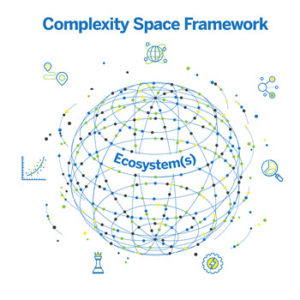Every organization and institution is a story about how Complexity Works!
We cannot help but pause following a week where disruptions challenged the “business as usual” approach to the very functioning and governing of our country.
In organizational systems, it is the unpredictable, unseen, and continually changing dynamics of external “ecosystems” that motivate action – often in response to disruptions that demand attention.
Understanding — and more significantly helping — leaders and individuals see, understand, and influence the patterns of thought, behavior, and results that emerge in environments of continuous and increasingly complex change is at the heart of the Complexity Space Framework.
 The Complexity Space Framework (CSF) provides lenses, language, metaphors, distinctions, and tools to help maintain institutional resilience while enabling organizations to move forward with actionable decisions.
The Complexity Space Framework (CSF) provides lenses, language, metaphors, distinctions, and tools to help maintain institutional resilience while enabling organizations to move forward with actionable decisions.
One of the things that makes the Complexity Space Framework unique is that it not only recognizes but embraces both traditional and complexity-based paradigms which are always present in the successful and sustainable practices of an organization.
If all of this sounds messy and a little chaotic, it is! We believe organizational change and improvement agents are overwhelmed by the messiness and therefore throw up their hands and retreat to traditional models because they provide them with concepts and tools to use – even if they are not especially effective.
In this context how do you describe successful responses and outcomes? What are your metrics for innovation and transformation? What tools are you using to change? Let the conversations begin.


